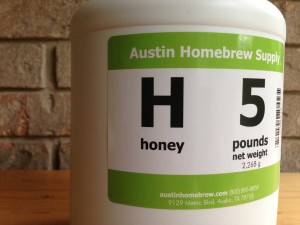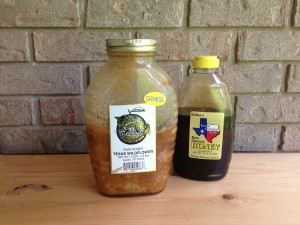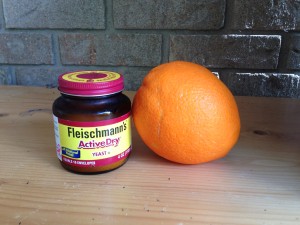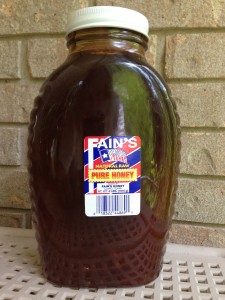
Recently, I interviewed Steve Piatz about his new book, “The Complete Guide to Making Mead: The Ingredients, Equipment, Processes, and Recipes for Crafting Honey Wine” (2014, Voyageur Press). Steve has been a mead maker for a long time, going back to the days when there was practically no information on mead making and people were still boiling their mead musts. Since then, he has won numerous awards for his meads, including the 2008 AHA Meadmaker of the Year Award. He is also a mead judge.
Interview with Steve Piatz
Old School Mead Recipe
Yesterday, I posted a mead recipe for first time mead makers. The recipe was designed to not only yield great mead, but also have a high probability of success. Part of the likelihood of success would be due to taking into consideration some of the newest ideas in mead making — the potassium levels of the mead, the pH and using staggered nutrient additions to help the fermentation along.
Today, I present a somewhat different type of mead recipe. This has been floating around the internet for some time, and quite a few people have been tried it and liked it. It may seem a bit “rustic” to advanced homebrewers or mead makers, but I’d just like to point out a few things before leaving it up to you to decide on the merits of this recipe.
Oranges are relatively high in potassium. Raisins are also fairly high in potassium. The combination of raisins and spices is going to add a small amount of tannins. (And in wine, tannins lend “structure.”) Fleishmann’s yeast is going to drop out early and leave a sweet mead. In wine, sweetness is balanced by acidity and oranges are loaded with citric acid. And finally, others have hit on the same combination of ingredients, more or less (although it’s possible that both of these draw from an older source). In any case, presented for your consideration, here’s Joe’s Ancient Orange Mead.
Dive Into Mead Making

Honey is the basis of mead. But honey alone can be difficult to ferment. Making a fruit mead (or melomel) is a great way to get started with meadmaking.
Here is a mead recipe for first time meadmakers who would like to try something with a high probability of success. One problem with making mead from honey alone is that there may not be enough potassium in the honey to sustain a healthy fermentation. Additionally the pH of an all-honey mead must may initially be too low. This recipe combines honey with cherries, a fruit with relatively high potassium levels, and whose juice is in a suitable pH range. (The pH of sweet cherry juice ranges from 3.8–4.5). It also contains a small amount of grape juice, which also has fairly high potassium levels and whose juice pH will work well in a wine-like fermentation. (Most wine is made from grapes.) Even if the pH of the honey is low, the fruit juices are more highly-buffered, so it will not be a problem.
One thing that might make beer brewers nervous is the lack of sanitation. The mead must is not boiled, nor are Campden tablets used to inhibit microorganisms, as in winemaking. The “dump and stir” method, advocated by Ken Schramm and employed here, works if you keep everything that goes into your must or contacts the fruit as clean as possible.
This recipe uses staggered nutrient additions to speed the fermentation along. Mead does not require fermentations that span for 6 or more months, as was the norm in “old school” meadmaking. If the yeast are fed nutrients as they need them, and in the right quantities, a mead fermentation can proceed nearly as quickly as a beer fermentation and aging may take only several weeks.
Although this is a “beginner’s” recipe, the quality is not substandard. If you use fresh, flavorful cherries and quality honey, following the instructions here will produce a wonderful mead.
Meads made with fruit are called melomels, so you can call this either a cherry mead or a cherry melomel. (Meads made from only honey and grapes are sometimes called pyments.) This produces a mead of 12% ABV. It’s strong, but not so strong that it will tax the wine yeast and lead to a prolonged fermentation. If you’re interested in mead and have been looking for a place to start, consider this recipe.
Potassium and pH in Mead

Most light honey varieties do not have enough potassium to support a healthy fermentation. Darker honeys might. Musts made from either may benefit from having their pH adjusted to 3.6 to 3.9.
There has been an increase in the interest in meadmaking among homebrewers in the past decade. This is due in large part to Ken Schramm’s book, “The Compleat Meadmaker” (2003, Brewers Publications), which introduced the “dump and stir” method of making mead without heating the must (the unfermented honey mixture). Not too long after the publication of his book, meadmakers discovered that you could get a more ordered fermentation if you staggered the yeast nutrient additions. This allows the meadmaker to dole out the nutrients as the yeast need them rather than adding all the nutrients at the beginning of the fermentation, and this leads to faster, more ordered fermentations.
Recently, I spoke to Schramm about two other things that have come to light in recent years that are required for optimal mead fermentations — the need to give the yeast sufficient potassium during fermentation, and the need to control the pH of a mead fermentation. By happy coincidence, you can do both of those by adding potassium carbonate (K2CO3).
Staggered Nutrient Additions in Mead Making
When making a straight honey mead, you’re asking the yeast to perform a gargantuan task — take the initial must (unfermented mead) from a high starting gravity down to a reasonable finishing gravity. In many cases, a drop in apparent attenuation of around 24 °Brix/SG 1.101 is desired. When accomplishing this, you also want the yeast to experience as little stress as possible. This will minimize the off characters produced by stressed yeast and allow the fermentation to progress in an orderly fashion. One key to achieving an ordered mead fermentation is ensuring that the yeast have adequate nutrition throughout the fermentation — and for this, both the amount and timing of nutrient additions play a role.
Yeast need nitrogen to survive and reproduce, but mead musts typically contain far too little free amino nitrogen (FAN) to support a fermentation that finishes in a reasonable amount of time and reaches a desirable final gravity. To support the fermentation of a must around 25 °Brix (SG 1.106), the yeast require about 300 ppm FAN. However, mead musts made from honey alone are usually under 20 ppm FAN. (Musts that include fruit may be substantially higher). To supply the yeast with enough nitrogen, and also other needed micronutrients, many mead makers rely on a blend of Fermaid-K and DAP (diammonium phosphate). The diammonium phosphate — a common wine yeast nutrient sold at any home winemaking shop — supplies the yeast with nitrogen. Fermaid-K — a complete yeast nutrient, which you’ll likely find in the same section of the wine shop as the DAP — supplies the must with not only nitrogen, but a range of other vitamins, minerals and biomolecules to support a healthy fermentation. Some meadmakers will also rehydrate their yeast with Go-Ferm, a yeast nutrient formulated to be added during dried yeast rehydration.
For most 5-gallon (19-L) mead recipes, the total amount of yeast nutrient added is in the range of 2.5 tsp. to 4 tsp. of mixed yeast nutrient. Dry meads, which start at lower original gravities, are on the low end of this range and the bigger sweet meads are at the high end. The blend of yeast nutrients usually ranges from a ratio of 1:1 to 2:1 DAP to Fermaid-K.



Recent Comments